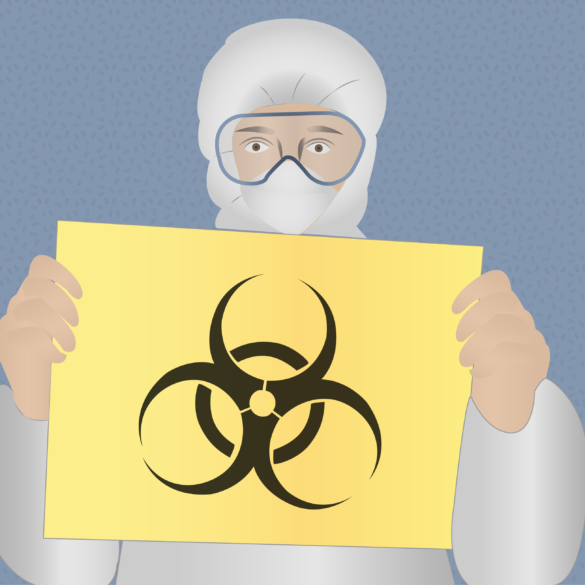When news of a disease outbreak hits the public, misinformation and lack of resources can cause some people to panic.
From 2014 to early 2016, more than 11 thousand people were struck with disease. Fever and fatigue were followed by impaired organ function, internal and external bleeding, and for some, death. The disease affected countless families as it spread to multiple countries. It was the largest outbreak of Ebola the world had ever seen.
Thousands of miles, an ocean, and half a country away, Ranna Jo Quimby watched it all unfold on her phone and TV in her Argos, Indiana, home. Suddenly the illness seemed to be there in her home, city, and state affecting the people she loved. It was so real to her that she decided to act.
What resulted was the creation of her Facebook group, Moms Talk Ebola. Ranna, who was concerned for her friends and family, wanted to create a space where accurate information about Ebola could be shared.
She was just one of millions of Americans who reacted with concern to the 2014 Ebola outbreak that, according to the World Health Organization (WHO), resulted in 11,308 total deaths between Sierra Leone, Liberia, and Guinea. According to a Washington Post and ABC news poll in 2014, 43 percent of Americans feared they or someone in their immediate family might catch the Ebola virus. Sixty-five percent were concerned about the possibility of a widespread Ebola epidemic in the United States.
In reality, the WHO reported four cases of Ebola in the U.S. between 2014 and 2016, with only one death. Despite this, millions of Americans feared for their lives.
Ranna became concerned after paying close attention to the media’s coverage. Many media outlets, she says, seemed to emphasize fear rather than provide what she considered factual information. She began to research Ebola on her own. Moms Talk Ebola became a space for her to prevent panic in others who felt similarly.
Tim Pollard, an associate professor of telecommunications at Ball State University, says some media entities print bold headlines and exaggerated stories because this type of content sells to the masses. Media companies that rely on viewership, advertisements, and clicks on their website might choose to present information in this way because the consumer is likely to stop when they see such “breaking news.” He says outlets who don’t require viewership for funding are more likely to offer accurate information.
Between October and November of 2014, the New England Journal of Medicine reported 76 to 81 percent of Americans were closely following news on Ebola. According to Media Matters for America, news networks including CNN, Fox News, MSNBC, CBS, NBC, and ABC collectively aired 975 segments on the Ebola virus.
This amount of coverage was paralleled by the public’s demand for immediate information.
According to Pollard, technology allows media companies to create content in minutes. Media is now a 24/7 environment, Pollard says, sometimes resulting in the sacrifice of accurate reporting. He says media companies can run into a problem when they must balance factual journalism with immediacy to inform the public while also keeping viewership.
Media isn’t entirely responsible for the strong response to Ebola in the U.S., however. Many people simply lacked knowledge about the disease itself and didn’t understand how it spread. The New England Journal of Medicine found that 85 percent of Americans polled said that they believed a person is likely to contract Ebola if they are sneezed or coughed on by someone with symptoms. According to the WHO, however, Ebola can only spread through bodily fluids.
This lack of understanding was also a concern of Ranna’s. A disease many people had never even heard of, she says, now had the possibility to affect them and their families. This fear “spread like wildfire.” After conducting research and learning for herself what the disease actually consisted of, Ranna used her Facebook group to educate and comfort others.
According to a 2016 Centers for Disease Control and Prevention report, an estimated 310,000 people required hospitalization for flu-related illnesses. Ebola affected four people in the U.S., killing one. With this type of knowledge, Ranna was able to understand Ebola’s minimal effect on Americans.
There are numerous ways to prevent the hysteria that results from diseases like Ebola. Ball State public health specialist Brandon Clidence worked at the Madison County Health Department during the outbreak. He had no personal experience handling Ebola, but he spoke to the public about public health issues. His experience, he says, has proved a need for solid sources of valid information and education to disseminate relevant public health information to the community.
Pollard believes media consumers need to step outside their “bubbles” and seek out different areas of media to challenge their views. In order to do this, Pollard says consumers must be skeptical of media and visit multiple news outlets. Many readers assume the first piece they read or see must be true, but it might not be. Exploring different sites and media companies can result in a more well-rounded, educated understanding of such events, Pollard says.
With most people not understanding how Ebola works and using media as a main source of information, these diseases can cause mass hysteria. Ranna says that, as a citizen and parent, the only way to be prepared for such events is to be informed.




